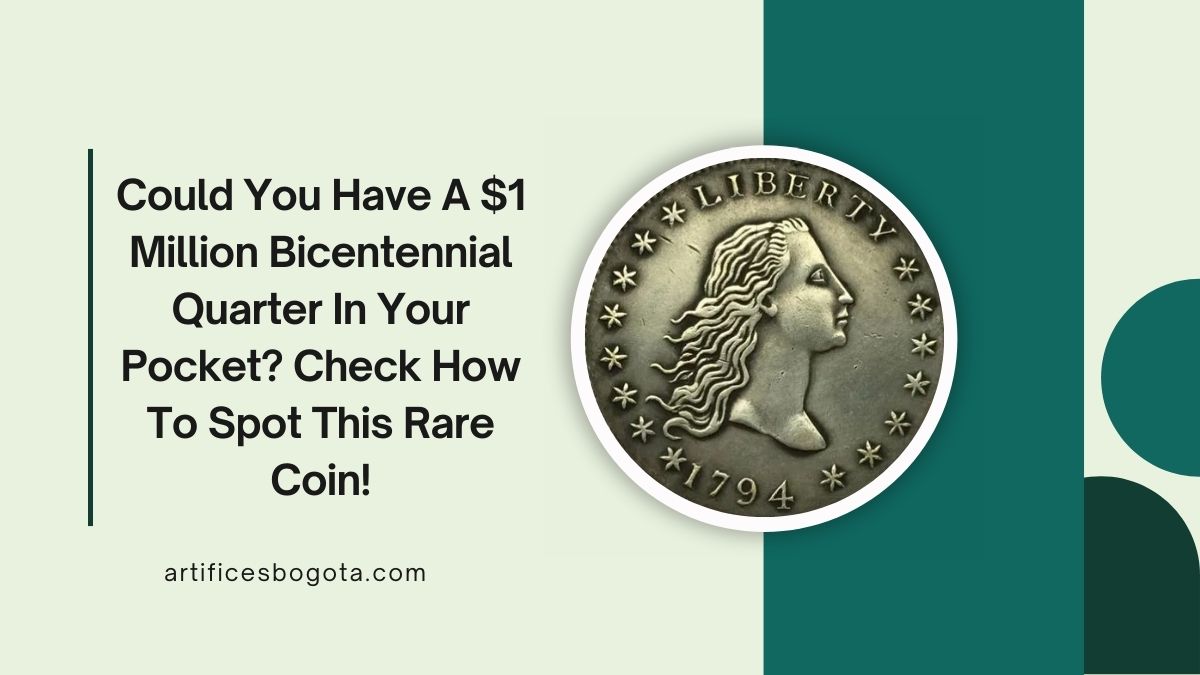The 1976 Bicentennial Quarter has become a legendary coin in the world of numismatics.
While rumors claim some of these quarters could be worth $1 million, the reality is that only specific rare varieties, such as error coins or silver proofs, hold significant value.
In this guide, we will explain how you can identify these valuable Bicentennial Quarters and maximize their worth.
History and Context of the Bicentennial Quarter
The Bicentennial Quarter was issued to commemorate the 200th anniversary of U.S. independence. The U.S. Mint produced these special quarters in 1975 and 1976, with a dual date of “1776-1976”.
The reverse features a colonial drummer, designed by Jack L. Ahr, surrounded by 13 stars, representing the original colonies.
More than 1.6 billion of these quarters were minted, with the following mint marks:
- Philadelphia (no mint mark)
- Denver (D)
- San Francisco (S), which also produced special silver-proof coins for collectors.
While most Bicentennial Quarters are relatively common, rare varieties and mint errors can make certain coins incredibly valuable. Let’s explore what makes these coins stand out.
Are Bicentennial Quarters Worth $1 Million?
The $1 million Bicentennial Quarter claim is largely a myth, often perpetuated by viral headlines and clickbait. In reality, no Bicentennial Quarter has ever officially sold for such a high price.
However, some rare Bicentennial Quarters have fetched impressive sums at auction.
For example, a 1976-S Silver Proof Quarter in PR70 condition (the highest grade) sold for $19,200 at Heritage Auctions. While this is an extraordinary case, it demonstrates that high-quality, rare coins can indeed be worth thousands.
Types of Valuable Bicentennial Quarters
Here are the key varieties of Bicentennial Quarters to look for:
| Type of Coin | Details | Value |
|---|---|---|
| 1976-S Silver Proof | Minted for collectors, not circulation; 40% silver composition. | $5–$300 (depending on grade); up to $19,200 for PR70. |
| Doubled Die Obverse (DDO) | Errors caused by die misalignment, creating doubling of text and numbers. | $100 to $1,000+, depending on condition. |
| Off-Metal Errors | Struck on incorrect planchets (nickels or foreign coins). | Can exceed $10,000, depending on rarity and condition. |
| Off-Center Strikes or Broadstrikes | Misalignment during minting causes off-center designs. | $50–$500+, based on severity and condition. |
Step-by-Step Guide: How to Spot a Rare Bicentennial Quarter
Step 1: Examine the Mint Mark
Check the obverse (front) side of the coin, just to the right of George Washington’s ponytail. You’ll find:
- No mint mark = Philadelphia
- “D” = Denver
- “S” = San Francisco (especially valuable if silver proof)
Step 2: Check the Coin’s Edge
Silver coins have a solid silver-colored edge, while copper-nickel coins (most Bicentennial Quarters) will show a distinct copper stripe around the edge.
Step 3: Look for Doubling or Errors
Use a magnifying glass (preferably 10x magnification) to inspect key areas such as LIBERTY, IN GOD WE TRUST, and 1776-1976. Look for:
- Doubling (double images of text or numbers)
- Weak strikes
- Off-center designs
Step 4: Weigh the Coin
If you suspect a coin is silver, weigh it:
- Silver quarters weigh 5.75 grams.
- Copper-nickel quarters weigh 5.67 grams.
Step 5: Get the Coin Graded
For coins you believe may be rare or in great condition, consider professional grading through services like PCGS or NGC. Grading is crucial to determine the coin’s true market value.
Practical Tips for Coin Collectors
- Store coins properly: Use archival-safe coin holders to protect them from scratches and tarnishing.
- Avoid cleaning coins: Cleaning can reduce a coin’s value by damaging its surface.
- Research auction results: Keep track of auction results to gauge the current value of rare coins.
- Join numismatic groups: Connecting with other collectors can provide valuable insight and opportunities to buy or sell rare coins.
While the idea of finding a $1 million Bicentennial Quarter in your pocket is largely a myth, the 1976 Bicentennial Quarter remains a fascinating piece of history—and certain rare types can fetch thousands of dollars.
By knowing what to look for, such as mint marks, errors, and silver proofs, you can increase your chances of discovering a hidden gem.
Remember to keep your coins in good condition, and consider professional grading to determine their true value.
FAQs
Are all Bicentennial Quarters valuable?
No, most Bicentennial Quarters are worth face value. Only certain rare varieties, such as silver proofs or coins with errors, hold significant value.
How much is a 1976-S Silver Proof Quarter worth?
A 1976-S Silver Proof Quarter in high-grade condition can be worth anywhere from $5 to $300, with PR70 examples fetching as much as $19,200.
How do I get my Bicentennial Quarter graded?
To get your coin professionally graded, you can submit it to services like PCGS or NGC for a thorough evaluation.
